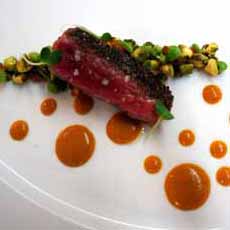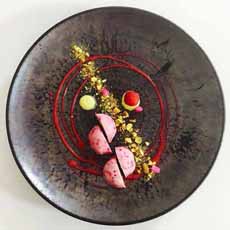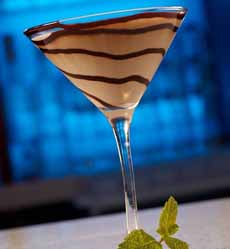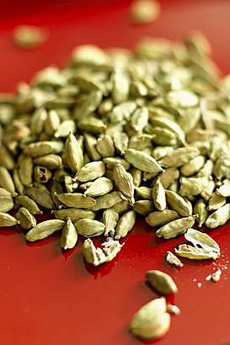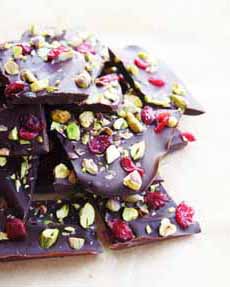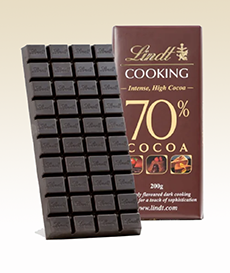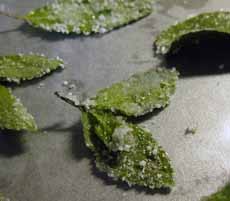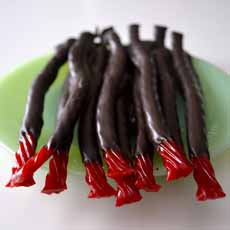|
As we close in on Christmas, we like to “Christmas-ize” our food, adding red and green garnishes to everything from scrambled eggs (green and red bell peppers or jalapeños) to desserts (mint leaves and raspberries).
We have fun looking for a different red and green combination at every meal.
For sandwiches, we add a plate garnish of lettuce, baby spinach or baby arugula and cherry tomatoes*, which can easily be moved onto the sandwich.
For an olive garnish, we use the bright green Castelvetrano olives and bright red peppadews.
Last year’s red and green food recipes include:
Christmas tartare: salmon or tuna
Christmas scallop crudo
Christmas sushi
Goat cheese rolled in dried cranberries and pistachio nuts
Pinwheel sandwiches
With cocktails,red and green pinwheel sandwiches
Today, we suggest a red and green “Christmas salad.”
The popular Caprese Salad is certainly red and green enough, but in the winter, when conventional tomatoes are out of season, you need to substitute: cherry or grape tomatoes, marinated sundried tomatoes, peppadews, pimientos (jarred red peppers), red bell peppers, etc.
You can serve something as simple as a beet and avocado salad. No prep is required, beyond slicing the avocado. The peeled, cooked ready-to-eat beets from Love Beets and other brands are terrific.
Then, just assemble the first three ingredients and drizzle the dressing (or place the dressing on the plate first).
Beets
Avocado
Mozzarella balls (ciliegine, perilii or other size
Balsamic vinegar and good olive oil (you can blend them into a vinaigrette)
Optional garnish: microgreens
Or, make a green salad from:
Cherry or grape tomatoes, whole or cut in hale
Radicchio or red endive
Radishes
Red bell pepper, sliced horizontally (we also use the mini bell peppers, bagged in mixed colors)
Red chile slices:
Red lettuce, chard, mustard greens
Red chile slices, from mild to hot
Whatever salad you choose, take this tip from KBlog: cut slices of toast into star shapes with a cookie cutter, and top your salad with a big star. Starfruit (carambola) also works.
SALAD HISTORY: WHY IS IT CALLED “SALAD” IF THERE ARE NO SALAD GREENS?
The original meaning of salad in European cuisine referred to a cold dish consisting of vegetables—lettuce, tomatoes, and cucumbers—topped with a dressing. Sometimes it containing seafood, meat, or eggs (think egg salad, tuna salad, etc.).
The modern word, which entered Middle English around 1350-1400, derives from the French salade, which dates back to the Latin salata, salty. Since Roman times, vegetables were seasoned with brine or salty oil-and-vinegar dressings.
The ancient Greeks and Romans alike ate mixed greens with dressing. Salads, both layered and dressed, were made popular in Europe by Roman imperial expansion (27 B.C.E. to 284 C.E.)
In the 1699 book, Acetaria: A Discourse on Sallets, John Evelyn attempted with little success to encourage his fellow Britons to eat fresh salad greens. (You can still find reprints in hardcover and digital versions.
|
|
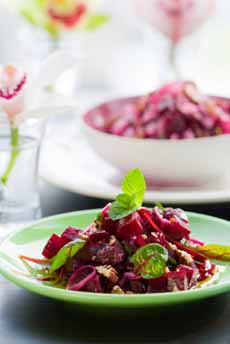
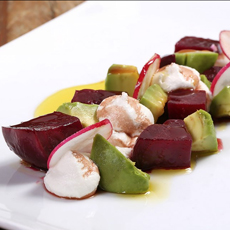
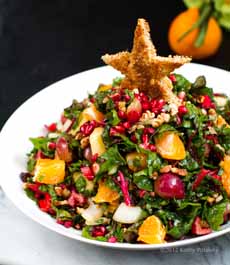
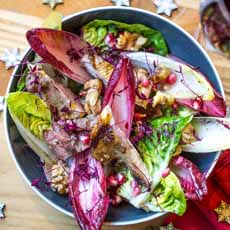
[1] Beet salad with red pickled onions and green accents (photo Sarsmis | IST). [2] Another beet salad, green with avocado and a balsamic reduction (photo courtesy Bar Eolo | NYC). [3] Kathy Patalsky of KBlog.LunchboxBunch.com tops her Christmas Tree Salad with a star-shaped toast crouton. Here’s her recipe. [4] Red endive and leafy lettuce with candied walnuts, from Gordon Ramsay.
|
MODERN SALADS
In the U.S. and Europe, salads of mixed greens salads (“green salads”) became popular in the late 19th century, and the concept expanded to Asia and other regions of the world.
The term “salad bar,” referring to a buffet laid out with salad-making ingredients so customers could make their own, seems to date to the 1960s. Restaurants in different parts of the country lay claim to its invention, including New York City’s Steak & Ale and Hawaii’s Chuck’’s Steak House. The attraction was the ability to customize one’s salad—and eat as much as you wanted (more history).
In truth, for centuries inns and boarding houses placed the food on a buffet for guests to help themselves (the “board” from “room and board”).
________________
*When tomatoes are out of season, cherry and grape tomatoes, raised in hothouses, have the best flavor. You can Substitute marinated sundried tomatoes, pimiento, red bell pepper, etc.
†The phrase is found in Shakespeare’s Antony and Cleopatra at the end of Act 1, when Cleopatra regrets her youthful dalliances with Julius Caesar: “…My salad days, / When I was green in judgment, cold in blood…”.
|
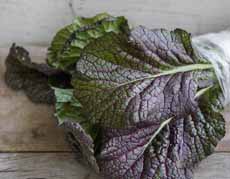
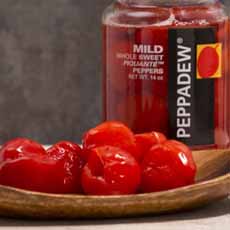
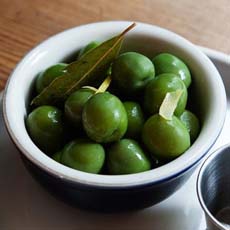
[5] Look for specialty salad greens like red mustard greens and chard (photo courtesy Good Eggs | SF). [6] Peppadews (photo courtesy Murray’s Cheese). [7] Castelvetrano olives (photo courtesy The Maiden Lane | NYC).
|
|
Mary, Queen of Scots (1542-1587) enjoyed salads of boiled celery root over greens. covered with creamy mustard dressing, truffles, chervil, and slices of hard-boiled eggs.
The phrase “salad days,” meaning a “time of youthful inexperience,” i.e. a young person who is “green,” was coined by Shakespeare†, in 1606.
Today, salads range far beyond the green salads (garden salads) of the 20th century—a concept so prevalent that in the U.S., the word salad unmodified (i.e., corn salad) refers to a green salad with torn, bite-size lettuce and other ingredients cut into small pieces.
But there other options that are rightfully called “salad”:
Various dishes made with beans and legumes, bread, cheese, eggs, fruit, meat, pasta, seafood, vegetables and starches (green beans, potatoes, grains) and more; in any combination; tossed, topped or “bottomed‡” with a dressing and served cold.
Ingredients cut in different shapes: sliced, diced, chopped, shredded, etc.
Dressings range from vinaigrettes and creamy dressings, seasoned with everything from mustard to sriracha.
Most salads are served cold, although warm vegetable salads are not uncommon, and classics such as German potato salad have always been served warm.
Salads can be served at any point during a meal:
Appetizer salads: Light salads that stimulate the appetite serve as the first course of the meal.
Side salads: These can accompany the main course as a side dish, or be served after it as the “salad course.”
Main course salads: Served for lunch or a light dinner, these containing a protein: cheese, hard-boiled egg, sliced beef, chicken breast, ham, or a combination, like Chef’s Salad or Cobb Salad.
Palate cleansing salads: Refreshing ingredients lime citrus segments, herbs or a combination can be used to “settle the stomach” after a heavy main course. Sorbet is another effective palate cleanser.
Dessert salads: Mixed fruits, gelatin with fruit, whipped cream or mascarpone and other ingredients can be garnished with cacao nibs, fruit coulis (a light purée), pomegranate arils, sweet dressing (e.g. honey-based, lemon poppyseed), sweet herbs (basil, lavender, mint, rosemary, star anise), toasted coconut, etc.).
MORE CHRISTMAS SALAD IDEAS
Salad Snack Tree
Christmas Stuffed Avocado
|
________________
‡Instead of topping the salad with dressing, it’s trendy to cover the plate with dressing and place the salad on top of it.
|
|


